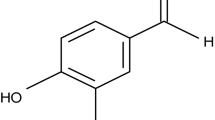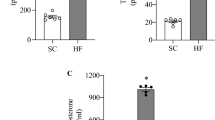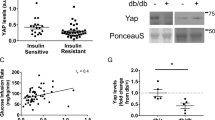Abstract
Objective:
To examine whether rosiglitazone alters gene expression of some key genes involved in mitochondrial biogenesis and oxidative capacity in skeletal muscle of type 2 diabetic patients, and whether this is associated with alterations in skeletal muscle oxidative capacity and lipid content.
Design:
Skeletal muscle gene expression, mitochondrial protein content, oxidative capacity and lipid accumulation were measured in muscle biopsies obtained from diabetic patients, before and after 8 weeks of rosiglitazone treatment, and matched controls. Furthermore, whole-body insulin sensitivity and substrate utilization were assessed.
Subjects:
Ten obese type 2 diabetic patients and 10 obese normoglycemic controls matched for age and BMI.
Methods:
Gene expression and mitochondrial protein content of complexes I–V of the respiratory chain were measured by quantitative polymerase chain reaction and Western blotting, respectively. Histochemical staining was used to quantify lipid accumulation and complex II succinate dehydrogenase (SDH) activity. Insulin sensitivity and substrate utilization were measured during a hyperinsulinemic–euglycemic clamp with indirect calorimetry.
Results:
Skeletal-muscle mRNA of PGC-1α and PPARβ/δ – but not of other genes involved in glucose, fat and oxidative metabolism – was significantly lower in diabetic patients (P<0.01). Rosiglitazone significantly increased PGC-1α (∼2.2-fold, P<0.01) and PPARβ/δ (∼2.6-fold, P<0.01), in parallel with an increase in insulin sensitivity, SDH activity and metabolic flexibility (P<0.01). Surprisingly, none of the measured mitochondrial proteins was reduced in type 2 diabetic patients, nor affected by rosiglitazone treatment. No alterations were seen in muscular fat accumulation upon treatment.
Conclusion:
These results suggest that the insulin-sensitizing effect of rosiglitazone may involve an effect on muscular oxidative capacity, via PGC-1α and PPARβ/δ, independent of mitochondrial protein content and/or changes in intramyocellular lipid.
This is a preview of subscription content, access via your institution
Access options
Subscribe to this journal
Receive 12 print issues and online access
$259.00 per year
only $21.58 per issue
Buy this article
- Purchase on Springer Link
- Instant access to full article PDF
Prices may be subject to local taxes which are calculated during checkout



Similar content being viewed by others
References
Patti ME, Butte AJ, Crunkhorn S, Cusi K, Berria R, Kashyap S et al. Coordinated reduction of genes of oxidative metabolism in humans with insulin resistance and diabetes: Potential role of PGC1 and NRF1. Proc Natl Acad Sci USA 2003; 100: 8466–8471.
Mootha VK, Lindgren CM, Eriksson KF, Subramanian A, Sihag S, Lehar J et al. PGC-1alpha-responsive genes involved in oxidative phosphorylation are coordinately downregulated in human diabetes. Nat Genet 2003; 34: 267–273.
Kelley DE, He J, Menshikova EV, Ritov VB . Dysfunction of mitochondria in human skeletal muscle in type 2 diabetes. Diabetes 2002; 51: 2944–2950.
Petersen KF, Dufour S, Befroy D, Garcia R, Shulman GI . Impaired mitochondrial activity in the insulin-resistant offspring of patients with type 2 diabetes. N Engl J Med 2004; 350: 664–671.
Petersen KF, Befroy D, Dufour S, Dziura J, Ariyan C, Rothman DL et al. Mitochondrial dysfunction in the elderly: possible role in insulin resistance. Science 2003; 300: 1140–1142.
McGarry JD . Banting lecture 2001: dysregulation of fatty acid metabolism in the etiology of type 2 diabetes. Diabetes 2002; 51: 7–18.
Wilson-Fritch L, Burkart A, Bell G, Mendelson K, Leszyk J, Nicoloro S et al. Mitochondrial biogenesis and remodeling during adipogenesis and in response to the insulin sensitizer rosiglitazone. Mol Cell Biol 2003; 23: 1085–1094.
Wilson-Fritch L, Nicoloro S, Chouinard M, Lazar MA, Chui PC, Leszyk J et al. Mitochondrial remodeling in adipose tissue associated with obesity and treatment with rosiglitazone. J Clin Invest 2004; 114: 1281–1289.
Bogacka I, Xie H, Bray GA, Smith SR . Pioglitazone induces mitochondrial biogenesis in human subcutaneous adipose tissue in vivo. Diabetes 2005; 54: 1392–1399.
Bergstrom J, Hermansen L, Hultman E, Saltin B . Diet, muscle glycogen and physical performance. Acta Physiol Scand 1967; 71: 140–150.
Higuchi R, Fockler C, Dollinger G, Watson R . Kinetic PCR analysis: real-time monitoring of DNA amplification reactions. Biotechnology (NY) 1993; 11: 1026–1030.
Schrauwen P, Mensink M, Schaart G, Moonen-Kornips E, Sels JP, Blaak EE et al. Reduced skeletal muscle uncoupling protein-3 content in prediabetic subjects and type 2 diabetic patients: restoration by rosiglitazone treatment. J Clin Endocrinol Metab 2006; 91: 1520–1525.
Cho M, Webster SG, Blau HM . Evidence for myoblast-extrinsic regulation of slow myosin heavy chain expression during muscle fiber formation in embryonic development. J Cell Biol 1993; 121: 795–810.
Koopman R, Schaart G, Hesselink MK . Optimisation of oil red O staining permits combination with immunofluorescence and automated quantification of lipids. Histochem Cell Biol 2001; 116: 63–68.
Skorjanc D, Heine G, Pette D . Time-dependent increase of succinate dehydrogenase activity in low-frequency stimulated rabbit muscle: a comparison between microphotometric and biochemical methods. Histochem Cell Biol 1997; 107: 47–55.
Martin TP, Vailas AC, Durivage JB, Edgerton VR, Castleman KR . Quantitative histochemical determination of muscle enzymes: biochemical verification. J Histochem Cytochem 1985; 33: 1053–1059.
Bergman RN, Finegood DT, Ader M . Assessment of insulin sensitivity in vivo. Endocr Rev 1985; 6: 45–86.
Peronnet F, Massicotte D . Table of nonprotein respiratory quotient: an update. Can J Sport Sci 1991; 16: 23–29.
Bruce CR, Anderson MJ, Carey AL, Newman DG, Bonen A, Kriketos AD et al. Muscle oxidative capacity is a better predictor of insulin sensitivity than lipid status. J Clin Endocrinol Metab 2003; 88: 5444–5451.
Richardson DK, Kashyap S, Bajaj M, Cusi K, Mandarino SJ, Finlayson J et al. Lipid infusion decreases the expression of nuclear encoded mitochondrial genes and increases the expression of extracellular matrix genes in human skeletal muscle. J Biol Chem 2005; 280: 10290–10297.
Sparks LM, Xie H, Koza RA, Mynatt R, Hulver MW, Bray GA et al. A high-fat diet coordinately downregulates genes required for mitochondrial oxidative phosphorylation in skeletal muscle. Diabetes 2005; 54: 1926–1933.
Al-Khalili L, Forsgren M, Kannisto K, Zierath JR, Lonnqvist F, Krook A . Enhanced insulin-stimulated glycogen synthesis in response to insulin, metformin or rosiglitazone is associated with increased mRNA expression of GLUT4 and peroxisomal proliferator activator receptor gamma co-activator 1. Diabetologia 2005; 48: 1173–1179.
Wilmsen HM, Ciaraldi TP, Carter L, Reehman N, Mudaliar SR, Henry RR . Thiazolidinediones upregulate impaired fatty acid uptake in skeletal muscle of type 2 diabetic subjects. Am J Physiol Endocrinol Metab 2003; 285: E354–E362.
Cha BS, Ciaraldi TP, Park KS, Carter L, Mudaliar SR, Henry RR . Impaired fatty acid metabolism in type 2 diabetic skeletal muscle cells is reversed by PPARgamma agonists. Am J Physiol Endocrinol Metab 2005; 289: E151–E159.
He J, Watkins S, Kelley DE . Skeletal muscle lipid content and oxidative enzyme activity in relation to muscle fiber type in type 2 diabetes and obesity. Diabetes 2001; 50: 817–823.
Goodpaster BH, He J, Watkins S, Kelley DE . Skeletal muscle lipid content and insulin resistance: evidence for a paradox in endurance-trained athletes. J Clin Endocrinol Metab 2001; 86: 5755–5761.
Acknowledgements
This work was financially supported by a grant from Glaxo SmithKline (GSK). Dr P Schrauwen was supported by a grant from the Royal Netherlands Academy of Arts and Sciences, and Dr M Hesselink is supported by a VIDI grant for innovative research from The Netherlands Organization for Scientific Research (Grant 917.66.359).
Author information
Authors and Affiliations
Corresponding author
Rights and permissions
About this article
Cite this article
Mensink, M., Hesselink, M., Russell, A. et al. Improved skeletal muscle oxidative enzyme activity and restoration of PGC-1α and PPARβ/δ gene expression upon rosiglitazone treatment in obese patients with type 2 diabetes mellitus. Int J Obes 31, 1302–1310 (2007). https://doi.org/10.1038/sj.ijo.0803567
Received:
Revised:
Accepted:
Published:
Issue Date:
DOI: https://doi.org/10.1038/sj.ijo.0803567
Keywords
This article is cited by
-
Effects of long-term taurine supplementation on age-related changes in skeletal muscle function of Sprague–Dawley rats
Amino Acids (2021)
-
Physical fitness status modulates the inflammatory proteins in peripheral blood and circulating monocytes: role of PPAR-gamma
Scientific Reports (2020)
-
Diabetes, myometrium, and mitochondria in pregnant women at term
Acta Diabetologica (2018)
-
Association of PGC-1α gene with type 2 diabetes in three unrelated endogamous groups of North-West India (Punjab): a case-control and meta-analysis study
Molecular Genetics and Genomics (2018)
-
Insulin Treatment Attenuates Decline of Muscle Mass in Japanese Patients with Type 2 Diabetes
Calcified Tissue International (2017)



